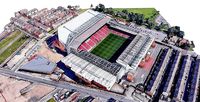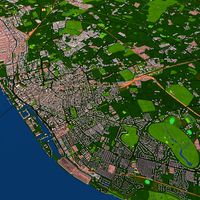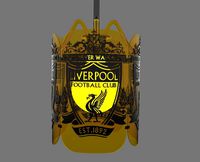CG Trader

Liverpool - Anfield 1963 | 3D
by CG Trader
Last crawled date: 1 year, 11 months ago
The stadium is named after the surrounding area, Anfield. The word originated in the combination of Old and Middle English words, which mean a field on a slope. Anfield, and its deviations, has been associated with the area since at the least 1642. It has been suggested that the name is linked to the influx of Irish people into the spreading city in the 1850s, and was associated with Annefield, outside New Ross, County Wexford, Ireland. Opened in 1884, Anfield was originally owned by John Orrell, a minor land owner who was a friend of Everton F.C. member John Houlding. Anfield's first league match was played on 8 September 1888, between Everton and Accrington F.C. Everton quickly improved as a team, and became Anfield's first league champions in the 1890–91 season. In 1892, negotiations to purchase the land at Anfield from Orrell escalated into a dispute between Houlding and the Everton F.C. committee over how the club was run. Events culminated in Everton's move to Goodison Park.[14] Houlding was left with an empty stadium, and decided to form a new club to occupy it. In 1892 the new team was called Liverpool F.C. and Athletic Grounds Ltd, and the club's first match at Anfield was a friendly played in front of 200 people on 1 September 1892, against Rotherham Town. Liverpool won 7–1. Liverpool's first Football League match at Anfield was played on 9 September 1893, against Lincoln City. Liverpool won 4–0 in front of 5,000 spectators. A new stand capable of holding 3,000 spectators was constructed in 1895 on the site of the present Main Stand. Designed by architect Archibald Leitch, the stand had a distinctive red and white gable, and was similar to the main stand at Newcastle United's ground St James' Park. Another stand was constructed at the Anfield Road end in 1903, built from timber and corrugated iron. After Liverpool had won their second League championship in 1906, a new stand was built along the Walton Breck Road. Local journalist Ernest Edwards, who was the sports editor of newspapers the Liverpool Daily Post and Echo, named it the Spion Kop; it was named after a famous hill in South Africa where a local regiment had suffered heavy losses during the Boer War in 1900. More than 300 men had died, many of them from Liverpool, as the British army attempted to capture the strategic hilltop. Around the same period a stand was also built along Kemlyn Road.
Similar models
cg_trader
$20

Liverpool - Anfield 1892 | 3D
... anfield was a friendly played in front of 200 people on 1 september 1892, against rotherham town. liverpool won 7–1. (wkikpedia)
cg_trader
$20

Liverpool - Anfield 1894 | 3D
...on and accrington f.c. everton quickly improved as a team, and became anfield's first league champions in the 1890–91 season.
3dwarehouse
free

Anfield Stadium
...was originally the home of everton from 1884 to 1891, before they moved to goodison park after a dispute with the club president.
cg_trader
$9

Anfield Stadium - Liverpool
...was originally the home of everton from 1884 to 1891, before they moved to goodison park after a dispute with the club president.
sketchfab
$15

Anfield Liverpool Stadium, England
...;s in 2020 by the main stand.
source: wikipedia.org - anfield liverpool stadium, england - buy royalty free 3d model by libanciel
3dwarehouse
free

Liverpool FC
...ded in 1892, the club joined the football league the following year and has played its home games at anfield since its formation.
3dwarehouse
free

Anfield V.2
...anfield v.2
3dwarehouse
liverpool f.c.'s new ground at stanley park
3dwarehouse
free

Goodfield Park
...000 they are a championship team old name was anfield park #anfield #everton #goodison_park #liverpool #liverpool_derby #new_firm
cg_trader
$20

Liverpool - Anfield 1957 | 3D
...ime for a match against everton to commemorate the 75-year anniversary of the liverpool county football association. (wikipedia)
cg_trader
$20

Everton - Goodison Park | 3D
... only yards from the corner flag. everton do not play early kick-offs on sundays in order to permit sunday services at the church
Anfield
humster3d
$150

3D model of Anfield
...er3d
buy a detailed 3d model of anfield in various file formats. all our 3d models were created maximally close to the original.
thingiverse
free

This is Anfield
...this is anfield
thingiverse
this is anfield sign
.2 resolution
20% infill
sketchfab
$15

Anfield Liverpool Stadium, England
...;s in 2020 by the main stand.
source: wikipedia.org - anfield liverpool stadium, england - buy royalty free 3d model by libanciel
cg_trader
$399

Anfield
...anfield
cg trader
3d anfield, available formats max, obj, 3ds, fbx, c4d, lwo, lw, lws, 3d anfield, ready for 3d animation and ot
cg_trader
$9

Anfield Stadium - Liverpool
...was originally the home of everton from 1884 to 1891, before they moved to goodison park after a dispute with the club president.
cg_trader
$15

Anfield Stadium - Liverpool FC
...liverpool fc
cg trader
3d anfield stadium - liverpool fc , available formats obj, fbx, blend, dae, ready for 3d animation and ot
cg_trader
$20

Liverpool - Anfield 1957 | 3D
...ime for a match against everton to commemorate the 75-year anniversary of the liverpool county football association. (wikipedia)
cg_trader
$20

Liverpool - Anfield 1894 | 3D
...on and accrington f.c. everton quickly improved as a team, and became anfield's first league champions in the 1890–91 season.
cg_trader
$20

Liverpool - Anfield 1892 | 3D
... anfield was a friendly played in front of 200 people on 1 september 1892, against rotherham town. liverpool won 7–1. (wkikpedia)
Liverpool
turbosquid
$1

Entrance to Liverpool
...yalty free 3d model entrance to liverpool for download as c4d on turbosquid: 3d models for games, architecture, videos. (1402736)
turbosquid
$24

Dantone liverpool sofa
...odel dantone liverpool sofa for download as max, obj, and fbx on turbosquid: 3d models for games, architecture, videos. (1482997)
turbosquid
$199

Liverpool City AUG 2020 with extra details
...ree 3d model liverpool city for download as obj, c4d, and fbx on turbosquid: 3d models for games, architecture, videos. (1423824)
3d_export
$25

liverpool fc
...ed and has a textured. textures map resolutions : diffuse 4000 pxl x 4000 pxl, normal map 4000 pxl x 4000 pxl. thanks for viewing
3ddd
$1

Roche Bobois Liverpool floor lamp
...iverpool floor lamp
3ddd
roche bobois
размер модели условно 200 см, так как на сайте производителя не указано никакой информации.
3d_export
$199

Liverpool city uk 40km
...t;1. suitable for games, games, education, architecture etc.<br>2. mainly used for town and urban planning, real estate etc
3d_export
$20

lamp decorative design
...lamp decorative design 3dexport liverpool fc decorative lamp...
3d_export
$25

Big 5 Premier League Football Club 3D Model
...model 3dexport football club english premier league arsenal chelsea liverpool man-city manchester city united big 5 premier league football...
3d_export
$11

Football Team Logo 3D Model
...dortmund borussia chelsea everton barcelona bayern southampton inter juventus liverpool manchester marsellie real swansea tottenham football team logo 3d...
3d_export
$20

Premiership And Championship Logo Pack 3D Model
...league championship logo logos sign sport team vray manchester liverpool chelsea tottenham arsenal derby premiership and championship logo pack...
1963
3d_export
$20

galaxie 1963
...galaxie 1963
3dexport
galaxie 1963
3d_export
$20

chevrolet 1963
...chevrolet 1963
3dexport
chevrolet 1963
turbosquid
$15

human-1963
...turbosquid
royalty free 3d model human-1963 for download as on turbosquid: 3d models for games, architecture, videos. (1170792)
3ddd
free

Пылесос Чайка 1963
...
3ddd
пылесос , ретро , ссср
пылесос чайка 1963
3d_export
$20

mercedes benz sl 1963
...mercedes benz sl 1963
3dexport
mercedes benz sl 1963
3d_export
$20

rollss roycee phantom 1963
...rollss roycee phantom 1963
3dexport
rollss roycee phantom 1963
3d_export
$65

volkswagen beetle 1963
...volkswagen beetle 1963
3dexport
3d model volkswagen beetle 1963 hi-poly , corona render ,3ds max , obj , fbx
turbosquid
$39

1963 Mexico UFO
... available on turbo squid, the world's leading provider of digital 3d models for visualization, films, television, and games.
turbosquid
$59

Vintage Radio Realtone 1963
...ee 3d model vintage radio realtone 1963 for download as blend on turbosquid: 3d models for games, architecture, videos. (1488668)
turbosquid
$10

Favourite 1963-1P Pendenti
... free 3d model favourite 1963-1p pendenti for download as max on turbosquid: 3d models for games, architecture, videos. (1260783)
